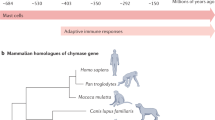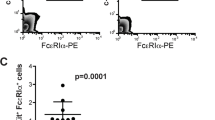Abstract
We have recently found that the number of mast cells in the skin of adult W/Wv mice is less than 1% of that observed in congeneic +/+ mice, and that no mast cells are detected in other tissues of W/Wv mice1. After the transplantation of bone marrow cells from congeneic +/+ mice, the number of mast cells in the skin, stomach, caecum and mesentery of the W/Wv mice increased to levels similar to those of the +/+ mice1. Study of the mast-cell number in the W/Wv mice at various times after transplantation suggested to us that mast cells might develop in groups, particularly in the skin and mesentery. In this report, we have attempted to elucidate the possible clonal origin of such mast-cell clusters from a single precursor cell, using giant granules of beige (CS7BL/6-bgJ/bgJ, Chediak–Higashi syndrome) mice as a marker to identify the origin of the mast cells2–4 (Fig. 1). We found that when WB-W/+×C57BL/6-Wv (WBB6F1)-W/Wv mice were injected with a mixture of bone marrow cells from beige C57BL/6 mice and normal C57BL/6 mice, more than 95% of mast-cell clusters consisted of either beige-type cells alone or normal-type cells alone. We conclude, therefore, that the cluster of mast cells originated from a single precursor cell.
This is a preview of subscription content, access via your institution
Access options
Subscribe to this journal
Receive 51 print issues and online access
$199.00 per year
only $3.90 per issue
Buy this article
- Purchase on Springer Link
- Instant access to full article PDF
Prices may be subject to local taxes which are calculated during checkout
Similar content being viewed by others
References
Kitamura, Y., Go, S. & Hatanaka, K. Blood 52, 447–452 (1978).
Chi, E. Y. & Lagunoff, D. J. Histochem. Cytochem. 23, 117–122 (1975).
Kitamura, Y., Shimada, M., Hatanaka, K. & Miyano, Y. Nature 268, 442–443 (1977).
Hatanaka, K., Kitamura, Y. & Nishimune, Y. Blood 53, 142–147 (1979).
Sheehan, H. L. & Storey, G. W. J. Path. Bact. 59, 336–337 (1947).
Murphy, E. D., Harrison, D. E. & Roth, J. B. Transplantation 15, 526–530 (1973).
Kitamura, Y., Hatanaka, K., Murakami, M. & Shibata, H. Blood 53, 1085–1088 (1979).
Kitamura, Y. & Go, S. Blood 53, 492–497 (1979).
McCulloch, E. A., Siminovitch, L., Till, J. E., Russell, E. S. & Bernstein, S. E. Blood 26, 399–410 (1965).
Mayer, T. C. & Green, M. C. Devl Biol. 18, 62–75 (1968).
Bernstein, S. E. Am. J. Surg. 119, 448–451 (1970).
Trentin, J. J. Am. J. Path. 65, 621–628 (1971).
Author information
Authors and Affiliations
Rights and permissions
About this article
Cite this article
Kitamura, Y., Matsuda, H. & Hatanaka, K. Clonal nature of mast-cell clusters formed in W/Wv mice after bone marrow transplantation. Nature 281, 154–155 (1979). https://doi.org/10.1038/281154a0
Received:
Accepted:
Issue Date:
DOI: https://doi.org/10.1038/281154a0
This article is cited by
-
New perspectives on the origins and heterogeneity of mast cells
Nature Reviews Immunology (2023)
-
Eucalyptus oil reduces allergic reactions and suppresses mast cell degranulation by downregulating IgE-FcεRI signalling
Scientific Reports (2020)
Comments
By submitting a comment you agree to abide by our Terms and Community Guidelines. If you find something abusive or that does not comply with our terms or guidelines please flag it as inappropriate.



